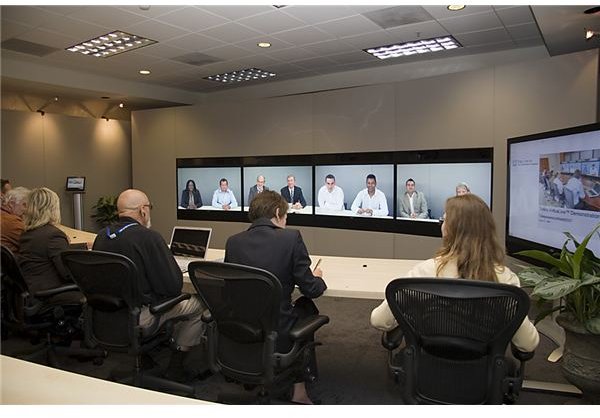Remote Worker Monitoring
Introduction
Whether a manager supervises a team of remote workers handling customer support calls, performing data entry tasks, or managing other complex business problems, monitoring employee work can be accomplished using software tools designed for improving collaboration and productivity. Establishing rules and responsibilities for workers who do not typically sit in company offices ensures that expectations get met consistently. Technology allows employees to work from anywhere and at any time. This promotes flexible schedules. Remote worker monitoring that includes tracking employee behavior and productivity ensures everyone follows the rules.
Use Instant Messaging and Email to Communicate Status
Instant messaging applications, such as Trillian or Adium, support several IM clients that allow users to exchange short messages. Answers to simple questions, such as when a project task is expected to be completed, can be communicated effectively using IM. More complex exchanges of information, such as the distribution of newsletters announcing changes to company policies and procedures, are typically more effectively handled by email. Process documentation containing multiple steps (procedures required to complete job tasks) tend to work best as attachments to either IM or email. IM allows a manager to conduct a dynamic conversation with multiple employees, much like occurs onsite. Monitoring employee access to these messages typically involves observing employee availability status and the timing associated with reading email messages.
Use Web Conferencing Software to Observe Employee Job Performance
Although managers schedule teleconferences and typically use the “Share Desktop” feature of meeting software such as NetMeeting and Live Meeting for conducting team meetings, these tools work well as coaching mechanisms, too. For example, if a manager notices an employee’s work contains multiple errors, he can schedule a personal conference call with his employee to observe the employee completing the task. Use the “Printscreen” function to capture screens to help employees remember which mistakes to avoid.
Conduct Video Conferences to Ensure Participants Remain Engaged
Using webcams for meetings allows a manager to see his staff and ensure they maintain eye contact during the meeting, rather than being distracted by their phone or email. Systems that use voice activation allow the camera to focus on the person speaking, making it more like a face-to-face conversation. Monitoring employee participation in meetings is easier when visual confirmation, such as head nodding or other cues, reinforce spoken communication. Managers can see gestures, body language, and facial expressions to monitor comprehension. Always have a backup plan, such as alternate phone lines, in case the Information Technology infrastructure fails during the session.
Conduct Surveys and Polls to Gather Employee Input
Use online survey tools such as SurveyMonkey, Qualtrics, or Zoomerang to conduct surveys and polls to gauge employee understanding of company policies and procedures. Managers can also monitor employee satisfaction by asking about needs. Gaps in support functions, such as training required to perform more effectively, can be validated. Then, managers should implement programs to fix problems the remote worker faces but frequently does not have the mechanism to reach management or leadership to address.
Establish Blogs, Wikis, or Forums–and Monitor Participation
Remote workers can contribute to documenting troubleshooting procedures just as easily as workers performing job tasks onsite. Provide incentives for contributing to company knowledge management strategies and use the reporting functions of social media technology tools to monitor employee entries. By establishing criteria for quality documents and implementing rigorous review procedures, managers can ensure that remote employees produce effective content. Software designed for collaboration can be monitored to verify remote worker additions.
Conclusion
If you supervisor remote workers, monitoring worker availability and output doesn’t have to be difficult. Through the use of web conferencing software, email applications, and social media technology, managers can create an atmosphere at least as productive as a face-to-face environment. Because remote workers function in a flexible environment, their work hours can span multiple time zones, resulting in increased coverage for customer and partner support. Monitoring their work involves observation and generating reports to validate participation and performance.
References and Image Credit
- Image Credit: Teliris VirtuaLive Unified Telepresence System (https://commons.wikimedia.org/wiki/File:Teliris_VL_Unified_1.jpg)
- “10 tools to help your remote workers stay in touch | 10 Things | TechRepublic.com .” TechRepublic Blogs mobile edition. https://blogs.techrepublic.com.com/10things/?p=268 (accessed November 30, 2010).
- “Extending Voice and Collaboration To Remote Users Enables Virtual Workforces and Complements Telecommuting | OnState.” Virtual Call Center Software and Virtual PBX Solution | OnState. https://www.onstate.com/extending-voice-and-collaboration-remote-users-enables-virtual-workforces-and-complements-telecommut (accessed November 30, 2010).
- Langhoff, June. The telecommuter’s advisor: real-world solutions for remote workers. 2nd ed. Newport, R.I.: Aegis Pub., 1999.
- “Work Shifting.” Work Shifting. https://www.workshifting.com (accessed November 30, 2010).
